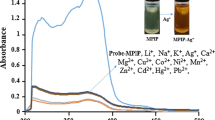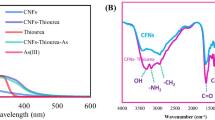Abstract
Pyridine based fluorescence probe, DFPPIC and its functionalized Merrifield polymer has been synthesized, characterized and used as an arsenate selective fluorescence sensor. Arsenate induced fluorescence enhancement is attributed to inter-molecular H-bonding assisted CHEF process. The detection limit for arsenate is 0.001 μM, much below the WHO recommended tolerance level in drinking water. DFPPIC can detect intracellular arsenate in drinking water of Purbasthali, West Bengal, India efficiently.

DFPPIC and its Merrifield conjugate polymer are used for selective determination and removal of arsenate from real drinking water samples of Purbasthali, a highly arsenic contaminated region of West Bengal, India. DFPPIC is very promising to imaging arsenate in living cells.























Similar content being viewed by others
References
Ensafi AA, Ring AC, Fritsch I (2010) Highly sensitive voltammetric speciation and determination of inorganic arsenic in water and alloy samples using ammonium 2-amino-1-cyclopentene-1-dithiocarboxylate. Electroanal 22(1175):1185
Boyle RW, Jonasson IR (1973) The geochemistry of arsenic and its use as an indicator element in geochemical prospecting. J Geochem Explor 2(251):296
Hasegawa H, Matsui M, Okamura S, Hojo M, Iwasaki N, Sohrin Y (1999) Arsenic speciation including ‘hidden’ arsenic in natural water. Appl Organomet Chem 13(113):119
Morales KH, Ryan L, Kuo TL, Wu MM, Chen CJ (2000) Risk of internal cancers from arsenic in drinking water. Environ Health Perspect 108(655):661
WHO (2011) Guidelines for drinking-water quality, 4th ed.; World Health Organization: Geneva, Switzerland
Quang DT, Kim JS (2010) Fluoro- and chromogenic chemodosimeters for heavy metal ion detection in solution and bio-specimens. Chem Rev 110(6280):6301
Kobayashi H, Ogawa M, Alford R, Choyke PL, Urano Y (2010) New strategies for fluorescent probe design in medical diagnostic imaging. Chem Rev 110(2620):6240
Callan JF, Silva APD, Magri DC (2005) Luminescent sensors and switches in the early 21st century. Tetrahedron 61(8551):8588
Demchenko AP (2008) Introduction to fluorescence sensing. Springer, New York
Xu Z, Xiao Y, Qian X, Cui J, Cui D (2005) Ratiometric and selective fluorescent sensor for CuII based on internal charge transfer (ICT). Org Lett 7(889):892
Wang JB, Qian XF, Cui JN (2006) Detecting Hg2+ ions with an ICT fluorescent sensor molecule: remarkable emission spectra shift and unique selectivity. J Org Chem 71(4308):4311
Gunnlaugsson T, Davis AP, Brien JEO, Glynn M (2002) Fluorescent sensing of pyrophosphate and bis-carboxylates with charge neutral PET chemosensors. Org Lett 4(2449):2452
Vance DH, Czarnik AW (1994) Real-time assay of inorganic pyrophosphatase using a high-affinity chelation-enhanced fluorescence chemosensor. J Am Chem Soc 116(9397):9398
Kim SK, Yoon J (2002) A new fluorescent PET chemosensor for fluoride ions. Chem Commun 770
Banerjee A, Sahana A, Das S, Lohar S, Guha S, Sarkar B, Mukhopadhyay SK, Mukherjee AK, Das D (2012) A naphthalene exciplex based Al3+ selective on-type fuorescent probe for living cells at the physiological pH range: experimental and computational studies. Analyst 137(2166):2175
Lim NC, Schuster JV, Porto MC, Tanudra MA, Yao L, Freake HC, Bruckner C (2005) Coumarin-based chemosensors for Zinc(II): toward the determination of the design algorithm for CHEF-type and ratiometric probes. Inorg Chem 44(2018):2030
Das S, Sahana A, Banerjee A, Lohar S, Guha S, Matalobos JS, Das D (2012) Thiophene anchored naphthalene derivative: Cr3+ selective turn-on fluorescent probe for living cell imaging. Anal Methods 4(2254):2258
Sahana A, Banerjee A, Das S, Lohar S, Karak D, Sarkar B, Mukhopadhyay SK, Mukherjee AK, Das D (2011) A naphthalene-based Al3+ selective fluorescent sensor for living cell imaging. Org Biomol Chem 9(5523):5529
Das S, Dutta M, Das D (2013) Fluorescent probes for selective determination of trace level Al3+: recent developments and future prospects. Anal Methods 5(6262):6285
Beer PD (1998) Transition-metal receptor systems for the selective recognition and sensing of anionic guest species. Acc Chem Res 31(71):80
Kim MJ, Konduri R, Ye H, MacDonnell FM, Puntoriero F, Serroni S, Campagna S, Holder T, Kinsel G, Rajeshwar K (2002) Dinuclear ruthenium(II) polypyridyl complexes containing large, redox-active, aromatic bridging ligands: synthesis, characterization, and intramolecular quenching of MLCT excited states. Inorg Chem 41(2471):2476
Nishizawa S, Kato Y, Teramae N (1999) Fluorescence sensing of anions via intramolecular excimer formation in a pyrophosphate-induced self-assembly of a pyrene-functionalized guanidinium receptor. J Am Chem Soc 121(9463):9464
Wu JS, Zhou JH, Wang PF, Zhang XH, Wu SK (2005) New fluorescent chemosensor based on exciplex signaling mechanism. Org Lett 7(2133):2136
Schazmann B, Alhashimy N, Diamond D (2006) Chloride selective Calix[4]arene optical sensor combining urea functionality with pyrene excimer transduction. J Am Chem Soc 128(8607):8614
Banerjee A, Sahana A, Guha S, Lohar S, Hauli I, Mukhopadhyay SK, Matalobos JS, Das D (2012) Nickel(II)-induced excimer formation of a naphthalene-based fluorescent probe for living cell imaging. Inorg Chem 51(5699):5704
Sahana A, Banerjee A, Lohar S, Guha S, Das S, Mukhopadhyay SK, Das D (2012) Cd(II)-triggered excimer–monomer conversion of a pyrene derivative: time dependent red-shift of monomer emission with cell staining application. Analyst 137(3910):3913
Sahana A, Banerjee A, Guha S, Lohar S, Chattopadhyay A, Mukhopadhyay SK, Das D (2012) Highly selective organic fluorescent probe for azide ion: formation of a “molecular ring”. Analyst 137(1544):1546
Peng X, Wu Y, Fan J, Tian M, Han K (2005) Colorimetric and ratiometric fluorescence sensing of fluoride: tuning selectivity in proton transfer. Org Chem 70(10524):10531
Das S, Guha S, Banerjee A, Lohar S, Sahana A, Das D (2011) 2-(2-Pyridyl) benzimidazole based Co(II) complex as an efficient fluorescent probe for trace level determination of aspartic and glutamic acid in aqueous solution: a displacement approach. Org Biomol Chem 9(7097):7104
Serin JM, Brousmiche DW, Frechet JMJ (2002) A FRET-based ultraviolet to near-infrared frequency converter. J Am Chem Soc 124(11848):11849
Albers AE, Okreglak VS, Chang CJ (2006) A FRET-Based approach to ratiometric fluorescence detection of hydrogen peroxide. J Am Chem Soc 128(9640):9641
Lee SH, Kim SK, Bok JH, Lee SH, Yoon J, Lee K, Kim JS (2005) Singlet oxygen generation via two-photon excited FRET. Tetrahedron Lett 46(8163):8167
Dichtel WR, Serin JM, Edder C, Frechet JMJ, Matuszewski M, Tan LS, Ohulchanskyy TY, Prasad PN (2004) Singlet oxygen generation via two-photon excited FRET. J Am Chem Soc 2004(126):5380–5381
Suresh M, Mishra S, Mishra SK, Suresh E, Mandal AK, Shrivastav A, Das A (2009) Resonance energy transfer approach and a New ratiometric probe for Hg2+ in aqueous media and living organism. Org Lett 11(2740):2743
Mahato P, Saha S, Suresh E, Liddo RD, Parnigotto PP, Conconi MT, Kesharwani MK, Ganguly B, Das A (2012) Ratiometric Detection of Cr3+ and Hg2+ by a naphthalimide-rhodamine based fluorescent probe. Inorg Chem 51(1769):1777
Sreenath K, Allen J, Davidson RMW, Zhu L (2011) A FRET-based indicator for imaging mitochondrial zinc ions. Chem Commun 47:11730–11732
Wandell RJ, Younes AH, Zhu L (2010) Metal - coordination - mediated sequential Chelation-enhanced fluorescence (CHEF) and fluorescence resonance energy transfer (FRET) in a heteroditopic ligand system. New J Chem 34(2176):2182
Lohar S, Banerjee A, Sahana A, Banik A, Mukhopadhyay SK, Das D (2013) A rhodamine–naphthalene conjugate as a FRET based sensor for Cr3+ and Fe3+ with cell staining application. Anal Methods 5(442):445
Sahana A, Banerjee A, Lohar S, Sarkar B, Mukhopadhyay SK, Das D (2013) Rhodamine-based fluorescent probe for Al3+ through time-dependent PET–CHEF–FRET processes and its cell staining application. Inorg Chem 52(3627):3633
Lohar S, Sahana A, Banerjee A, Banik A, Mukhopadhyay SK, Matalobos JS, Das D (2013) Antipyrine based arsenate selective fluorescent probe for living cell imaging. Anal Chem 85(1778):1783
Sahana A, Banerjee A, Lohar S, Panja S, Mukhopadhyay SK, Matalobos JS, Das D (2013) Fluorescence sensing of arsenate at nanomolar level in a greener way, naphthalene based probe for living cell imaging. Chem Commun 49(7231):7233
Banerjee A, Sahana A, Lohar S, Panja S, Mukhopadhyay SK, Das D (2014) Visible light excitable fluorescence probe and its functionalized Merrifield polymer: selective sensing and removal of arsenate from real samples. RSC Adv 4(3887):3892
Denton DA, Suschitzky H (1963) Synthetic uses of polyphosphoric acid. J Chem Soc 4741:4743
Austin E, Gouterman M (1978) Porphyrins. XXXVII. Absorption and emission of weak complexes with acids, bases, and salts. Bioinorg Chem 9(281):298
Van Houten J, Watts RJ (1976) Temperature dependence of the photophysical and photochemical properties of the tris (2, 2′-bipyridyl) ruthenium(II) ion in aqueous solution. J Am Chem Soc 98(4853):4858
Park SW, Kim CW, Lee JH, Shim G, Kim KS (2011) Comparison of arsenic acid with phosphoric acid in the interaction with a water molecule and an alkali/alkaline-earth metal cation. J Phys Chem A 115(11355):11361
Benesi HA, Hildebrand JH (1949) A spectrophotometric investigation of the interaction of iodine with aromatic hydrocarbons. J Am Chem Soc 71(2703):2707
Biswas B (2010) West Bengal, India, Geomorphic controls of arsenic in ground water in Purbasthali I & II Blocks of Burdwan district. Int J Environ Sci 4(429):439
Acknowledgments
Financial support from DST (Govt. of West Bengal) is gratefully acknowledged. S. Nandi and A. Sahana are grateful to UGC and CSIR, New Delhi for fellowship. We thank CAS (B. U.) for infrastructural and financial help.
Author information
Authors and Affiliations
Corresponding author
Rights and permissions
About this article
Cite this article
Nandi, S., Sahana, A., Sarkar, B. et al. Pyridine Based Fluorescence Probe: Simultaneous Detection and Removal of Arsenate from Real Samples with Living Cell Imaging Properties. J Fluoresc 25, 1191–1201 (2015). https://doi.org/10.1007/s10895-015-1606-1
Published:
Issue Date:
DOI: https://doi.org/10.1007/s10895-015-1606-1




